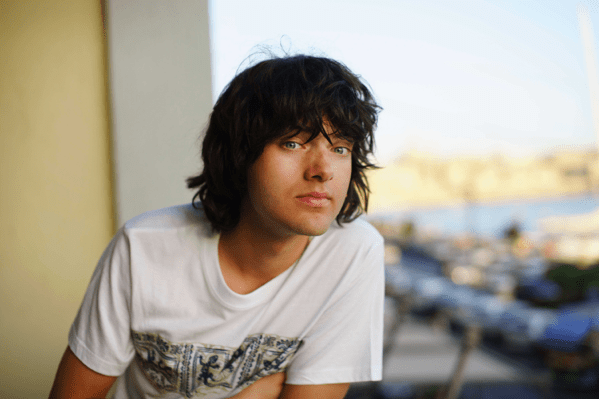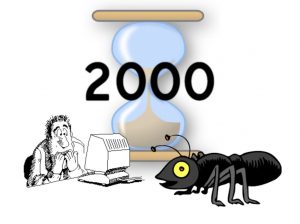“For society to progress, we should not only move forward but also cleanup after ourselves.”1

By NOAA | Courtesy of Wikimedia Commons
Over the last forty years, our oceans have been filling with tons of plastic debris. The plastic is carried by the ocean currents and it all converges in five major accumulation zones, commonly called “Garbage Patches.”2 Many scientists predict that if this problem is not solved, there will be major consequences. Garbage will block the sunlight in the oceans, resulting in many species of sea plants and animals dying. Moreover, the environment will be affected in such ways that the entire food chain of the world will suffer major changes. Dutch inventor Boyan Slat has come up with an idea to solve this problem.3
Boyan Slat is a 24-year-old Dutch inventor, who has been interested in engineering projects since he was very young. At the age of fourteen, he even set a Guinness World Record by launching 213 water rockets at the same time.4 When he was sixteen, he went diving in the waters of Greece and was so surprised to see more plastic underwater than fish. That was the moment when Slat began the idea of cleaning up the ocean. Over the last forty years, millions of tons of plastic have entered the oceans creating huge garbage patches. The largest such patch is located between Hawaii and California. After his trip to Greece, Boyan became obsessed with this problem. During high-school, all of his science projects were about understanding this problem and trying to solve the “million-dollar” question “why this cleanup is considered impossible?”5

After high-school, Boyan was invited to TEDtx to tell the world his idea. At first, his ideas didn’t seem to be really interesting to the public, so he went on with his life. He started working as an aerospace engineer in TU Delft, but he just couldn’t let go of his idea. But the simple thought of not being able to come up with a solution to this major problem was killing him. He was thinking about the terrible consequences, in several years, for the planet if no one did anything.6
After several months he came into the spotlight again because some news sites had picked up his TED speech and became interested in his story. Slat even dropped out of college to pursue his dream.7
He had always enjoyed solving problems and puzzles. But this time was going to be different. This time the puzzle was to get rid of the plastic in the oceans. He just had to find the perfect pieces to accomplish that. At the young age of eighteen, he founded a non-profit organization called The Ocean Cleanup, in order to develop new technology to tackle this almost impossible task.8
And this is when the real adventure began for Slat. Instead of picking up all the plastic bottles with nets, which according to experts it would cost millions of dollars and take thousands of years, his idea was to use the power of natural currents to gather plastic into long floating rubber barriers. But developing this great plan wasn’t an easy task. It required money, time, and many experts in different fields. In an interview, Slat said “When I started, I thought I would likely fail, and I still might, but considering the scale of the problem, it was important to at least try.”9
His ideas started coming together when several experts, such as engineers, oceanographers, recycling companies, and scientists volunteered to complete a study, which ended up indicating that the The Ocean Cleanup project had a feasible and viable method for removing large amounts of plastic. But this was only the first step. Slat still needed a lot of money to start the project. So his next step was to take his story and project to the rest of the world. He has since gained the support of 160 countries, 38,000 funders, and collected over 2 million USD. With this money, he was closer to accomplishing his dream, but, again, this was just another piece of a big puzzle.10

Later, The Ocean Cleanup started developing prototypes, then getting into trials, failing and learning from mistakes, and finally the got it right. They mapped an area of 3.5 million squared kilometers of plastic and marine debris, known as the “great pacific garbage patch.” After that, Slat gave an interview arguing that most people had an image of this patch as an island where you can practically walk on, but that couldn’t be more wrong. It stretches for millions of kilometers and it would take thousands of years to clean it up.11 So he targeted that area to clean first. The first Ocean Cleanup system was launched on September 8, 2018. He is hoping to clean up to 50% within five years.12
This amazing story is only getting started, so if you want to follow the progress of this project, you can follow their official organization page (www.theoceancleanup.com).
- The Ocean Cleanup, “The largest Cleanup history,” The Ocean Cleanup, June 6, 2017. Accessed September 8. www.theoceancleanup.com. ↵
- NOAA, “Great Pacific Garbage Patch,” National Geographic, June 5, 2015. Accessed September 8. https://www.nationalgeographic.org/encyclopedia/great-pacific-garbage-patch/. ↵
- U.S. Government Publishing Office, “Endangered status for North Pacific and North Atlantic Right Whales,” (Federal register: Vol. 73, No. 45. Thursday, 2008), 12024-12030. ↵
- Viveke Venema, “The Dutch boy mopping up a sea of plastic,” BBC News, October 17, 2017. Accessed September 7. https://www.bbc.com/news/magazine-29631332. ↵
- Susan Caminiti, “Thiel backing 22-year-old’s dream to clean up world’s oceans,” CNBC.com, April 22, 2017. Accessed September 5. https://www.cnbc.com/2017/04/20/thiel-benioff-backing-22-year-olds-dream-to-clean-up-worlds-oceans.html. ↵
- The Ocean Cleanup, “How it all began,” The Ocean Cleanup, June 6, 2017. Accessed September 8. www.theoceancleanup.com. ↵
- The Ocean Cleanup, “How it all began,” The Ocean Cleanup, June 6, 2017. Accessed September 8. www.theoceancleanup.com. ↵
- Susan Caminiti, “Thiel backing 22-year-old’s dream to clean up world’s oceans,” CNBC.com, April 22, 2017. Accessed September 5. https://www.cnbc.com/2017/04/20/thiel-benioff-backing-22-year-olds-dream-to-clean-up-worlds-oceans.html. ↵
- Viveke Venema, “The Dutch boy mopping up a sea of plastic,” BBC News, October 17, 2017. Accessed September 7. https://www.bbc.com/news/magazine-29631332. ↵
- The Ocean Cleanup, “Milestones,” The Ocean Cleanup, June 6, 2017. Accused September 8. www.theoceancleanup.com. ↵
- Marian Liu, “Great Pacific Garbage Patch Now Three Times the Size of France,” CNN, 23 Mar. 2018. Accessed September 6 2018. www.cnn.com/2018/03/23/world/plastic-great-pacific-garbage-patch-intl/index.html. ↵
- The Ocean Cleanup, “Milestones,” The Ocean Cleanup, June 6, 2017. Accessed September 8. www.theoceancleanup.com. ↵



78 comments
Angel Torres
It is individuals like Boyan Slat that give me hope for the future. At such a young age he was able to be impacted by the amount of plastic he saw diving in the waters of Greece, which motivated him to take action. Slat dropped out of college to fulfill his dream on creating a solution to the garbage problem around the world. I have to Gove Slat a lot of props because it is definitely not easy to solve the garbage issue. The article provides a good storyline to raise awareness for the garbage issue but to also raise support for the ocean cleanup project.
Irene Astran
We need more innovators like this man. It is sad that our decisions affect creatures that have no say in the matter. They are inhabitants of lands and seas far away from us but every decision we make as it resorts to waste and our food sources creates consequences for them. Thank you for bringing a story like this to the forefront.
Miguel Camarillo-Cohen
Great article! Plastic is killing us because we are consuming small particles of plastic debris. Ms. Ramirez made a very complying argument that we must “clean after ourselves”, clean our ocean if we want a future on this planet. Earth needs us to change how we deal with plastic. It is killing earth’s living species in the ocean. The world needs more inventors like Boyan Slat.
Richard Morales
This article was very insightful and provided me with in depth knowledge of a relevant problem for my generation and those to come. I learned about how there are millions of tons of plastic pollution in our oceans and how Boyan Slat is trying to reduce the pollution. I was gladdened to learn about this smart inventor and how he teamed with engineers and oceanographers to try and make a difference for our one and only planet earth.
Ximena Mondragon
This article is very informative however I wish it was longer so the author could provide more information. This topic is so important because this is the only earth we have and we need to take care of it. We are so privilege to not see where all our waste goes however it is going somewhere. If we don’t start worrying about it now, it will be too late for the future.
Daniela Cardona
This article was honestly so cool, maybe even one of the best I have read. It’s so great how current it is, it allows us to look forward to something rather than back. We really need more young minds to act on their ideas like Slat. There are so many problems arising in our world that can only be stopped by mass help. It needs to come from the youth as we have seen older generations obviously neglect the planet for so long. I think the Ocean Cleanup plan is honestly so excited and made me very happy to hear. I will most definitely be following it.
Madeline Torres
I had no idea that the ocean between California and Hawaii was the worst polluted area of the ocean. It really makes me wonder just how much we do not care for our environment. Reading about Slat’s story was very inspiring and it’s amazing to read how someone can be so passionate about changing the world for the better. Overall, absolute great article and very interesting read!
Alejandra Chavez
I was shocked to read the words “garbage patch” and “ocean” in relative terms. I knew there was an issue but I wasn’t able to understand it as deep as I needed to. I’m highly impressed with this young man’s drive. Gaining the support of so many countries is a feasible task and I’ve gained an odd sense of motivation when he decided to keep going even though he thought he’d fail. I’m appreciative of this article. I’ll probably google it later on.
Jocelyn Moreno
I’ve never heard of the Ocean Cleanup. It’s so great to hear that someone is trying to make a big difference in our world. Plastic and Garbage is hurting our world as well as the creatures of the sea. I’m glad Boyan Slat decided to never give up on his wish to clean up the ocean because his determination is going to help our Planet become cleaner and maybe even last longer. I can’t wait to see the results of the Ocean Cleanup.
Donte Joseph
I had never heard of the “Ocean Cleanup Project”, but after hearing about it and reading about what it represents I am excited for it. It is true that there is much trash in the oceans, and if no one picks it up, who will? Boyan Slat is very inspirational in the fact that he is that someone who is willing to help make a change, and everyone should follow his example to make big changes in the world.